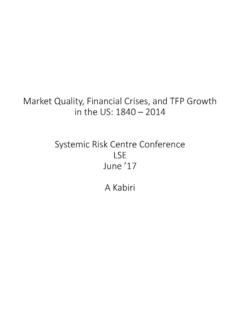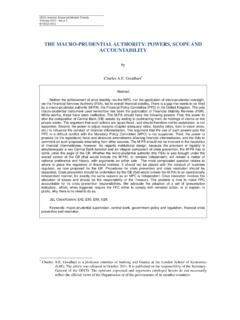Transcription of Capital Flows and Macroprudential ... - Systemic …
1 Capital Flows and Macroprudential policies A MultilateralAssessment of Effectiveness and ExternalitiesJohn Beirneaand Christian Friedrichb January 7, 2016 AbstractUsing a sample of up to 75 advanced and emerging economies over the period 1999-2012,we examine the effectiveness of Macroprudential policies (MPPs) in managing cross-borderbank Flows . Conditioning on the structure of the banking sector in the MPP-implementingcountry, we find that higher regulatory quality and a higher credit-to-deposit ratio increasethe effectiveness of MPPs, while a higher cost-to-income ratio has the opposite effect. Ad-ditionally, we find that the structure of the domestic banking sector underpins asset classspillovers from MPPs, while geographical spillover effects from MPPs are a function of bank-ing sector conditions both at home and Words: Macroprudential policies , international Capital Flows , banking sectorJEL Classification: F3, F5, G11, G21 aJohn Beirne: European Central Bank, International Policy Analysis Division, Sonnemannstrasse 20, Frank-furt am Main, 60314, Germany; e-mail: Also affiliated to the Centre for Empirical Finance,Brunel University, London, UB8 3PH, United Friedrich(Corresponding Author): Bankof Canada, International Economic Analysis Department, 234 Laurier Avenue West, Ottawa, ON K1A 0G9,Canada.
2 E-mail: We would like to thank, without implicating, Ana Mar a Aguilar,Michael Ehrmann, Kristin Forbes, Marcel Fratzscher, Atish Ghosh, Mathias Hoffmann, C edric Tille, CharlesWyplosz, and all conference participants at the6thBIS CCA Research Conferencein Mexico City, the13thIN-FINITI Conference on International Financein Ljubljana, the2014 German Economists Abroad Meetingin Kiel,the17thAnnual Conference on Macroeconomic Analysis and International Financein Crete, theInternationalConference on Global Economy, Policy Challenges and Market Responsesin London, the2015 Bank of CanadaFellowship Learning Exchangeand the2013 Bank of Canada Annual Conference on International MacroeconomicPolicy Cooperationin Ottawa as well as seminar participants at theJoint Vienna Macro Seminar, theGraduateInstitute Genevaand theEuropean Central Bankfor helpful discussions, comments, and suggestions.
3 The viewsexpressed in this paper are those of the authors and do not necessarily represent those of the European CentralBank or the Bank of IntroductionThis paper examines the effectiveness of Macroprudential policies (MPPs) in managing inter-national Capital Flows , with a focus on international bank the onset of the globalfinancial crisis in 2007/08, and the rise in Capital inflows to emerging economies in particular,MPPs have been placed prominently on the research agendas of major central bank and interna-tional policy institutions. The literature to date finds that the effect of Capital flow managementtools on Capital Flows is largely limited to changing the composition of Flows , rather than thevolume. However, there has been no attempt in the literature to consider the role played by thestate of the domestic banking sector in underpinning the success of such tools, and in particularMPPs, in reducing Capital Flows .
4 Indeed, this is surprising given that a significant part of foreigncapital inflows are intermediated by the domestic banking sector. This paper fills the gap in theliterature by testing a range of financial channels through which MPPs may affect internationalcapital Flows . These channels include the level of regulatory quality and the operational andintermediation efficiency of banks. Where MPPs are found to be effective, an assessment is thenmade of policy spillovers to other asset classes and countries, , spillovers conditioned on thestructure of the banking recognising the important role played by Capital inflows as a driver of economic growthand investment, there is also ample evidence to suggest that foreign Capital inflows have con-tributed to fuel credit booms, to provoke over-indebtedness, and to facilitate the emergence ofcurrency and maturity mismatches.
5 In order to mitigate the negative effects associated with ex-cessive Capital inflows, countries mainly relied on Capital controls in the past. However, tacklingexcessive inflows of foreign Capital with MPPs instead comes with the advantage that MPPspertain to the financial system unlike Capital controls, which distinguish investors by the resi-dence principle. In addition, policy-makers might not only be interested in the impact of MPPson Capital Flows in order to actively influence Capital Flows . There is also an increasing need tobetter understand potential externalities along the international dimension arising from MPPsthat are primarily targeted to reduce domestic academic research on MPP effectiveness has typically looked at the effect of variousMPPs on selected components of the domestic financial system, finding that MPPs have generallybeen effective in reducing Systemic risk ( , Lim et al.)
6 , 2011; Habermeier et al., 2011; Qureshiet al., 2012). However, the MPP literature lacks convincing evidence of their impact on foreigncapital Flows so far. Using a large sample of up to 75 advanced and emerging economies overthe period 1999 to 2012, we make the following two contributions to the , we show robustly that the structure of the domestic banking sector matters for theeffectiveness of MPPs. We specifically find that higher regulatory quality and a higher credit-to-deposit ratio in the MPP-implementing country increase the effectiveness of MPPs, while ahigher cost-to-income ratio has the opposite effect. If all three financial variables are evaluatedat their most favorable 25th(10th) percentile, we observe highly significant marginal effects ofMPPs with a reduction of bank inflows in % of GDP by ( ) percentage points, while thecorresponding effects with an evaluation at the median of their distributions amounts to only areduction by percentage points.
7 This difference is of substantial economic this paper, we focus primarily on the implementation of policies that apply to the financial system of acountry and have the (implicit or explicit) goal to reduce Systemic risk over a well-defined time period. Becauseof their Systemic nature, we refer to these policies generally as Macroprudential policies . This definition isloosely based on Borio (2003). Macroprudential policies can be distinguished from microprudential policies , thatthe author defines as policies that are targeted to reduce idiosyncratic risks for individual financial institutionsand usually apply on a permanent , we consequently assess the presence of spillover effects as a function of bankingsector conditions at home and abroad. We find that spillovers to closely related asset classes inthe MPP-implementing country respond identically to domestic financial conditions.
8 Moreover,we find that especially for advanced countries, the banking sector structures of other MPP-implementing countries in the same geographical region are important determinants of spilloversto bank Flows into the domestic the growing literature on MPP effectiveness, most of the theoretical work done indicatesthat MPPs can be welfare-enhancing (Lorenzoni, 2008; Korinek, 2010; Federico, 2011). Jeanne(2014) presents a model to show that while Macroprudential policy implementation may leadto spillovers of Capital elsewhere, the case for international co-ordination of MPPs is subjectto factors affecting global demand and more pervasive during a bust (under-utilised globalresources) than a boom. On the empirical side, there is a certain overlap with the traditionalliterature on Capital Flows . Magud et al.
9 (2011) provide an extensive meta-study on the empiricalliterature of Capital controls, where they conclude that Capital controls can make monetary policymore independent, influence the composition of Flows and, to a lesser extent, reduce exchangerate pressures. However, no significant impact is found on the level of net Capital Flows . Morerecently, a number of studies have emerged that focus jointly on the effectiveness of capitalcontrols and MPPs. Habermeier et al. (2011) summarize the literature to date and note thatcapital controls have had only a small effect on the volume of Flows and the resulting currencyappreciation but can change the composition of most closely related studies to this paper are Lim et al. (2011) and Qureshi et al. (2012).Lim et al. (2011) find that a number of MPP instruments can indeed reduce the procyclicalityof credit.
10 Successful instruments include caps on the loan-to-value ratio and the debt-to-incomeratio as well as limits on credit growth, reserve requirements and dynamic provisioning. Theonly outcome variable in the analysis that is related to Capital Flows and currency mismatchesis associated with cross-sectional risks and comprises the ratio of foreign liabilities to foreignassets. The authors find that only MPPs that limit net open positions in foreign currency havea mitigating effect on the ratio mentioned above. All other MPPs turn out to be ineffectivein this setup. Qureshi et al. (2012) examine the effectiveness of a broad set of Capital flowmanagement tools that includes economy wide Capital controls, Capital controls to the financialsector, foreign currency-related prudential measures and domestic prudential regulation for 51emerging markets.






